
Modern Organocopper Chemistry
.pdf
258 7 Copper-catalyzed Enantioselective Conjugate Addition Reactions of Organozinc Reagents
62A. Mandoli, L. A. Arnold, A. H. M. de Vries, P. Salvadori, B. L. Feringa, Tetrahedron: Asymmetry
2001, 12, 1929.
63A. Alexakis, C. Benhaim, X. Fournioux, A. van den Heuvel, J.-M. Leveˆque, S. March, S. Rosset,
Synlett 1999, 1811.
64M. Kitamura, T. Miki, K. Nakano, R. Noyori, Tetrahedron Lett. 1996, 37, 5154.
65a) G. Sarakinos, E. J. Corey, Org. Lett. 1999, 1, 811; b) G. P. J. Hareau,
M.Koiwa, S. Hikichi, F. Sato, J. Am. Chem. Soc. 1999, 121, 3640;
c) T. Hanazawa, M. Koiwa, G. P. J. Hareau, F. Sato, Tetrahedron Lett.
2000, 41, 2659 and references cited therein.
66Recent non-enzymatic kinetic resolutions, c.f.: a) E. N. Jacobsen,
Acc. Chem. Res. 2000, 33, 421; b) S. Bellemin-Laponnaz, J. Tweddell, G. Ruble, F. M. Breitling, G. C. Fu,
Chem. Commun. 2000, 1009; c) J. Yun, S. L. Buchwald, J. Org. Chem.
2000, 65, 767; d) X. Feng, L. Shu, Y. Shi, J. Am. Chem. Soc. 1999, 121, 11002.
67a) H. B. Kagan, J. C. Fiaud, Top. Stereochem. 1988, 18, 249; b) A. H. Hoveyda, M. T. Didiuk, Curr. Org. Chem. 1998, 2, 489.
68a) E. J. Corey, F. J. Hannon, Tetrahedron Lett. 1990, 31, 1393; b) T. A. Blumenkopf, C. H. Heathcock, J.
Am. Chem. Soc. 1983, 105, 2354; c) N.
L.Allinger, C. K. Riew, Tetrahedron Lett. 1966, 1269; d) C. H. Heathcock,
T.C. Germroth, S. L. Graham, J. Org. Chem. 1979, 44, 4481.
69R. Naasz, L. A. Arnold, A. J. Minnaard, B. L. Feringa, Angew. Chem. 2001, 113, 953; Angew. Chem. Int. Ed. 2001, 40, 927.
70a) C. H. Wong, G. M. Whitesides,
Enzymes in Synthetic Organic Chemistry, Elsevier, London, 1994; b)
H. van der Deen, A. D. Cuiper, R. P. Hof, A. van Oeveren, B. L. Feringa, R. M. Kellogg, J. Am. Chem. Soc. 1996, 118, 3801.
71It is not clear why the selectivity factor is not higher in this resolution, as might be expected from Fig. 7.10. One possible explanation is that the kinetics with Me2Zn might be more complicated than with the other zinc reagents, in which case the formula in Ref. 67a would no longer be valid; see also: D. G. Blackmond, J. Am. Chem. Soc. 2001, 123, 545.
72R. Imbos, M. H. G. Brilman, M. Pineschi, B. L. Feringa, Org. Lett.
1999, 1, 623.
73R. Imbos, A. J. Minnaard, B. L. Feringa, Tetrahedron, 2001, 57, 2485.
74P. Knochel, D. Seebach, Synthesis,
1982, 1017.
75H. Scha¨fer, D. Seebach, Tetrahedron
1995, 51, 2305.
76N. Sewald, V. Wendisch,
Tetrahedron: Asymmetry 1998, 9, 1341.
77A. Alexakis, C. Benhaim, Org. Lett.
2000, 2, 2579.
78J. P. G. Versleijen, PhD Thesis, University of Groningen, 2001.
79J. P. G. Versleijen, A. M. van Leusen, B. L. Feringa, Tetrahedron Lett. 1999, 40, 5803.
80R. Naasz, L. A. Arnold, M. Pineschi, E. Keller, B. L. Feringa,
J. Am. Chem. Soc. 1999, 121, 1104.
81Z. G. Hajos, D. R. Parrish, J. Org. Chem. 1974, 39, 1615.
82B. L. Feringa in Transition Metals for Organic Synthesis, M. Beller, C. Bolm
(Eds.), Wiley, Weinheim, 1998, Vol. 2, pp. 307–315.
83R. Naasz, L. A. Arnold, A. J. Minnaard, B. L. Feringa, Chem. Commun. 2001, 735.
84L. A. Arnold, R. Naasz, A. J. Minnaard, B. L. Feringa, J. Am. Chem. Soc. 2001, 123, 5841.
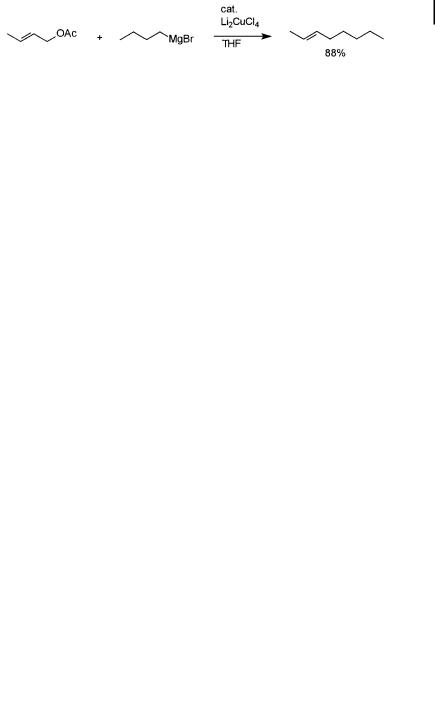
Modern Organocopper Chemistry. Edited by Norbert Krause
Copyright > 2002 Wiley-VCH Verlag GmbH
ISBNs: 3-527-29773-1 (Hardcover); 3-527-60008-6 (Electronic)
259
8
Copper-Mediated Enantioselective Substitution Reactions
A. Sofia E. Karlstro¨m and Jan-Erling Ba¨ckvall
8.1
Introduction
Copper-mediated substitution reactions constitute an important, and much used, tool for the construction of new carbon–carbon bonds in organic synthesis [1]. Many di erent types of substitution and addition reactions mediated by organocopper reagents have been established as fundamental reactions in the repertoire available to the synthetic chemist. The first example of a copper-mediated substitution reaction was described by Gilman in 1936 [2], and involved reactions between phenylcopper – PhCu – and acid chlorides and allylic halides. Copper-mediated substitution reactions at saturated carbon were reported in 1952, also by Gilman [3], who found that the copper-catalyzed reaction between methyl iodide and methylmagnesium reagents gave ethane. These copper-catalyzed coupling reactions between alkyl halides and Grignard reagents were later studied in more detail (Eq. 1) [4, 5].
ð1Þ
In the 1952 paper mentioned above [3], Gilman reported on the formation of lithium dimethylcuprate from polymeric methylcopper and methyllithium. These socalled Gilman cuprates were later used for substitution reactions on both saturated [6] and unsaturated [7, 8, 9] substrates. The first example of a cuprate substitution on an allylic acetate (allylic ester) was reported in 1969 [8], while Schlosser reported the corresponding copper-catalyzed reaction between an allylic acetate and a Grignard reagent (Eq. 2) a few years later [10].
ð2Þ
Copper-mediated or copper-catalyzed substitution reactions can be performed on a number of di erent substrates (Scheme 8.1). Stoichiometric organocopper reagents
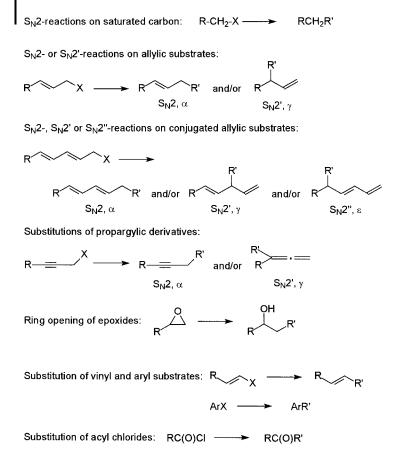
260 8 Copper-Mediated Enantioselective Substitution Reactions
Scheme 8.1. Copper-mediated substitution reactions. Reagents: ‘‘R20 Cu ’’ or ‘‘R0Cu’’.
R0Cu, or lithium or magnesium homocuprates R20 CuM (M ¼ Li, MgX), are frequently used, but a number of catalytic processes have also been developed. These processes normally utilize a catalytic amount of a copper salt CuY and a stoichiometric amount of an organometallic reagent R0M (M ¼ Li, MgX, ZnX, etc.). The leaving groups used include halides, esters, sulfonates, and epoxides, among others.
Copper-catalyzed asymmetric substitution reactions can be classified into three major types:
(1)diastereoselective reaction of achiral nucleophiles with chiral substrates,
(2)diastereoselective reaction of chiral nucleophiles with prochiral substrates, and
(3)enantioselective reaction of achiral nucleophiles with prochiral substrates in the presence of chiral catalysts.
From the data available it is clear that diastereoselective reactions of type (1) are very useful for control over absolute stereochemistry, but they require stoichiometric amounts of the chiral auxiliary. Reactions of type (3), on the other hand, have so far

8.2 Allylic Substitution 261
been less used, but they have the advantage that only a small amount of chiral material is required, and that a chiral auxiliary does not have to be cleaved o and recovered after the reaction.
As discussed in Chapt. 6, copper-mediated diastereoselective addition and substitution reactions are well studied methods for the construction of chiral centers in organic molecules. The development of copper-mediated enantioselective substitution reactions, however, is still at an early stage.
The use of chiral catalysts as an approach to enantiomerically enriched products by means of copper-mediated substitution reactions is covered in this chapter. Reactions in which a chiral auxiliary resides in the leaving group of the substrate will also be dealt with, since these reactions provide direct and e cient routes to single enantiomers of the desired products. Most studies so far have been concerned with allylic substrates, with a new chiral center being produced in the course of a selective SN20 reaction.
8.2
Allylic Substitution
The copper-mediated allylic substitution reaction has been the target of research e orts from many di erent research groups during the last 30 years. This transformation is fascinating since the substitution reaction of a substrate with a leaving group in the allylic position can occur in two di erent modes. These two modes are: (i) direct displacement of the leaving group in an SN2 fashion, often also referred to as a substitution, and (ii) SN20 displacement of the leaving group involving an allylic shift of the double bond, also referred to as g substitution (Scheme 8.2). In a more highly conjugated allylic system, such as a 1,3-pentadienol derivative, the substitution can occur even further away from the leaving group.
Scheme 8.2. Copper-catalyzed allylic substitution.
Depending on the substrate and the other reaction parameters, very high regioselectivities towards either a or g substitution can be obtained. In certain cases, the regioselectivity can easily be switched between the two modes by changing the reaction conditions [11]. Compared to, for example, palladium(0)-catalyzed allylic substitution reactions, the possibility of switching between SN2 and SN20 selectivity
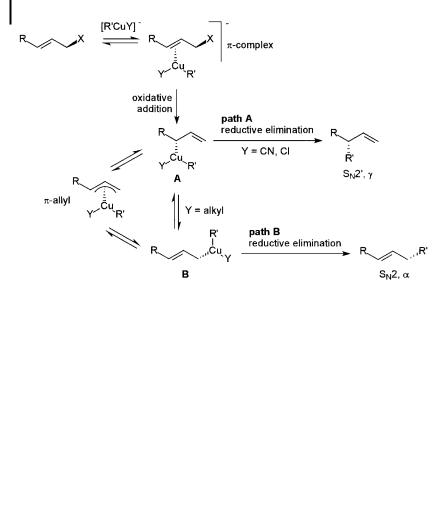
262 8 Copper-Mediated Enantioselective Substitution Reactions
in copper-mediated reactions is an advantage. A further advantage is that a fairly broad range of organometallic reagents can be used: lithium, magnesium, and zinc reagents, for example. In this way, both nonfunctionalized and functionalized substituents can be introduced.
Mechanistically, these reactions are considered to proceed by way of oxidative addition of the organocopper reagent to yield Cu(III) intermediates [9, 11–13], giving the final substitution products through reductive elimination as presented schematically in Scheme 8.3. The oxidative addition is thought to be highly g-selective, which would initially produce the s-allyl complex A. A fast reductive elimination from this complex (that is, when Y is electron-withdrawing) would give the g product. Under slow reductive elimination conditions (Y ¼ electron-donating), the s-allyl complex A would have time to rearrange to the more stable s-allyl complex B. Reductive elimination from the latter would give the a product.
Scheme 8.3. Proposed mechanisms of allylic substitution reactions.
SN20-selective reactions between primary allylic substrates and organocopper reagents result in the creation of new chirality in previously achiral molecules, and it is tempting to try to take advantage of this for the development of enantioselective allylic substitution reactions.
8.2.1
Allylic Substrates with Chiral Leaving Groups
Most asymmetric induction processes with chiral auxiliaries involve a stereodi erentiating reaction that a ords one diastereomer as the primary product. To obtain the desired enantiomer, the chiral auxiliary must be removed. Highly diastereoselective reactions between organocopper reagents and allylic substrates with
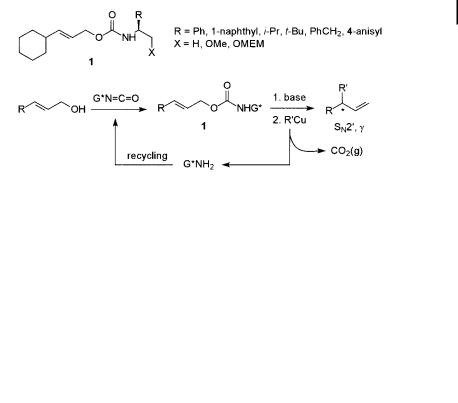
8.2 Allylic Substitution 263
chiral auxiliaries attached to the allylic backbone have been developed [14]. If, however, an allylic substrate with a chiral leaving group can be utilized, the enantiomerically pure product can be obtained directly.
The first attempts to develop reactions o ering control over the absolute stereochemistry of a chiral center, created by g-selective substitution of an achiral allylic alcohol-derived substrate, involved the use of chiral auxiliaries incorporated in the nucleofuge. The types of stereodirecting groups utilized vary, and have included sulfoximines [15], carbamates [16], and chiral heterocyclic sulfides [17–19].
Denmark and co-workers reported the first example in 1990 [16], using substrates 1, synthesized from achiral allylic alcohols and readily available optically active amine auxiliaries. Substrates 1 were then employed in copper-mediated allylic substitution reactions, as shown in Scheme 8.4.
Scheme 8.4. Employment of allylic carbamates 1 in copper-mediated asymmetric substitution.
Substitution reactions of achiral allylic carbamates have been studied previously, by Gallina and Goering, for example [20]. An intriguing feature of these substrates is the preference for formation of the SN20 product in which the newly introduced group appears on the same side as the leaving group was previously (syn selectivity). As has been shown in several independent studies, the more commonly used substrates, such as allylic esters and halides, usually react with anti selectivity. The opposite syn stereochemistry observed for carbamates has been explained by coordination of the copper reagent to the leaving group, followed by an intramolecular delivery of the nucleophile. This would be consistent with the fact that a chiral carbamate of type 1, as designed by Denmark et al., can produce significant asymmetric induction in the g-position even though that involves a 1,7-transfer of chirality in this case.
Optimization of the reaction conditions was undertaken in order to find the best SN20/SN2 ratio and the best substrate conversion. Initial formation of a lithium carbamate salt of 1 on treatment with MeLi, followed by treatment with a stoichiometric amount of MeCu in Et2O at 0 C, produced clean SN20 selectivity and isolation of the desired alkene in 75% yield. A variety of chiral carbamates 1 were investigated, the substrate with R ¼ 1-naphthyl and X ¼ OMe being chosen as the candidate for further studies. It is noteworthy that substrates in which X ¼ H gave

264 8 Copper-Mediated Enantioselective Substitution Reactions
very low selectivity, and also that incorporation of a coordinating oxygen functionality seems to be necessary for high enantioselectivity. A striking di erence between aliphatic and aromatic auxiliaries, in favor of the latter, was also noted. Finetuning of the reaction parameters resulted in high enantiomeric excesses (b88% ee) in reactions with MeCu, n-BuCu, and PhCu (Scheme 8.5). Et2O had to be used as solvent since the use of THF dramatically reduced the enantiomeric excesses.
Scheme 8.5. Optimized reaction conditions for reactions between allylic carbamate 1 (R ¼ 1-naphthyl, X ¼ OMe) and organocopper reagents R00Cu.
The main disadvantage of this reaction is that it is necessary to use stoichiometric amounts, or more, of the organocopper reagent, together with stoichiometric amounts of the chiral auxiliary. The leaving group chiral auxiliary, however, can be recovered and recycled after the reaction.
Another highly selective system was designed by Gais et al. in the course of the synthesis of isocarbacyclin [15a]. In conjunction with this study it was found that optically pure allylic sulfoximines undergo regioselective and enantioselective allylic substitution reactions with organocopper reagents [15b]. Since the chirality is at the sulfur atom, the chiral center is directly connected to the allylic fragment in sulfoximes 5 and 6, used in this study (Scheme 8.6).
Endocyclic allylic sulfoximines 5 were synthesized from cycloalkanones and lithiated enantiomerically pure (S)-S-methyl-S-phenylsulfoximine, by addition and subsequent elimination and isomerization of the intermediate vinylic sulfoximines.
The allylic sulfoximines 5 were subjected to treatment with organocopper reagents. The regioselectivity could be controlled by variation of the reaction conditions, and a highly a-selective reaction was obtained with homocuprates R2CuLi/ LiI. Organocopper reagents RCu/LiI in the presence of BF3 OEt2 (Yamamoto conditions) [14, 21], on the other hand, gave g-selective reactions producing exocyclic alkene products (Scheme 8.6). Regioselectivity showed no clear dependence on the solvent, since both Et2O/Me2S and THF/Me2S were suitable for highly selective reactions.
For 5b, derived from cyclopentanone, a maximum ee of 90% was achieved with the bulky copper reagent t-BuPh2SiO(CH2)4Cu/LiI. Et2O had to be used as solvent for optimal results in this case, but THF was the best solvent in others. Low temperature conditions ( 100 C, or from 100 to 78 C) were used for all the enan-
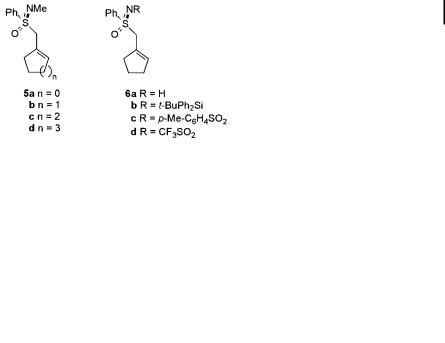
8.2 Allylic Substitution 265
Scheme 8.6. Reactions between endocyclic sulfoximines 5 and organocopper reagents.
tioselective reactions. Organocopper reagents functionalized with ether groups in the g- or d-positions gave ees of 63–71%. Simple n-alkylcopper reagents also produced enantioselectivities of around 70%. Further investigation of copper reagents using TMSCH2Cu and PhCH2Cu met with little success, since the g selectivity was lost. The loss of g selectivity in the case of TMSCH2Cu/LiI was attributed to an equilibrium process with the corresponding homocuprate, which in parallel experiments was shown to give high a selectivity. For 5c (n ¼ 2), ees between 60 and 73% were observed for all Grignard reagents studied (both functionalized and nonfunctionalized), together with high g selectivities. Further enlargement of the cycloalkene ring, as in 5d, did not produce any improvement, with treatment with BuCu/LiI/BF3 OEt2 in Et2O giving an ee of 60%. A smaller cyclobutene ring in the allylic sulfoximine, as in 5a, gave only a 27% ee with the butylcopper reagent.
It was demonstrated that the chiral auxiliary can be recovered after the reaction as the corresponding sulfinamide Me(H)NS(O)Ph, with virtually complete retention of configuration at the sulfur atom.
To explore the influence of the nitrogen substituent in the sulfonimidoyl group, substrates 6 were synthesized and tested. Sulfoximines bearing a silyl group (6b) or hydrogen (6a) on nitrogen, however, did not react at all; neither with RCu, nor with R2CuLi. The N-tosyl-substituted (6c) and N-CF3SO2-substituted (6d) substrates were less reactive than 5b, but a orded similar regioselectivities under both a- selective and g-selective conditions. The observed ees for these substrates were lower (around 30%), however.

266 8 Copper-Mediated Enantioselective Substitution Reactions
Gais et al. also investigated the mechanism of the reaction, with respect to the influence of additives. It was concluded, at least for the organocopper reagent TMSCH2Cu, that LiI and BF3 OEt2 are necessary additives for reaction with an allylic sulfoximine. The role of metal halide could be to promote formation of heteroleptic cuprates RCu MHal or (RCu)m(MHal)n. Organocopper reagents prepared in the absence of lithium salts were unreactive. BF3 probably acts through substrate or intermediate activation. NMR experiments in the presence of BF3 showed that BF3 coordinates to the nitrogen atom in sulfoximines bearing the NMe group, but not in the triflylor tosyl-substituted substrates 6d and 6c, in which the electronegative substituent on nitrogen prevents coordination.
Calo` et al. have thoroughly investigated the use of allylic electrophiles containing heterocyclic leaving groups in regioselective allylic substitution (Scheme 8.7) [22].
Scheme 8.7. Substitution of heterocyclic allylic substrates.
From the data obtained under various conditions it was concluded that the selectivity is governed by preliminary chelation of the leaving group to the organocopper reagent RCu MgX2. The organocopper reagents RCu MgX2, prepared from a Grignard reagent and an excess of a copper salt, selectively gave the SN20 products, while homocuprates R2CuMgX were SN2-selective. The more electrophilic nature of RCu MgX2 results in better coordinating properties than in the R2CuMgX reagent and it was suggested that the SN20-selective reaction is due to intramolecular delivery of the coordinated RCu reagent.
The heterocyclic component in the leaving group o ers possibilities for introduction of chirality. Optically active oxazolin-2-yl and thiazolin-2-yl allyl thioethers 7 were thus chosen as substrates (Scheme 8.8) [17].
Scheme 8.8. Enantioselective substitution of oxazolin-2-yl and thiazolin-2-yl allyl thioethers.

8.2 Allylic Substitution 267
The regioselectivity of the reaction was found to be solvent-dependent, with Et2O favoring SN20 products, and THF favoring SN2 products, in accordance with results from studies of similar systems [22]. As expected, a high ratio of CuBr to Grignard reagent favored the SN20 path. Various chiral heterocyclic sulfides 7 were thus treated with i-PrMgBr or n-BuMgBr in Et2O in the presence of excess CuBr, yielding the desired g-products with ees ranging from 50 to 98%, depending on the substrate used. From the results obtained, it was concluded that steric hindrance around the leaving group nitrogen atom resulted in higher enantioselectivity. The geometry of the allylic double bond (E or Z ) plays a decisive role, as shown by one example in which the two double bond isomers gave opposite enantiomers with comparable enantioselectivities, even though the leaving group was of the same absolute stereochemistry.
Chelate formation between the leaving group and the organocopper reagent can also be used to increase the reactivity of the leaving group so that it reacts chemoselectively, in preference to a di erent potential leaving group [18]. In this way, an allylic substrate bearing a pivalate and a sulfide of benzothiazole can, through a g- selective reaction, yield homoallylic pivalates exclusively. With a chiral allylic sulfide, the reaction could produce optically active homoallylic pivalates in chemoselective, regioselective, and enantioselective fashion. Use of a chiral benzimidazole sulfide as the leaving group, as in 8, resulted in selective replacement of the benzimidazole to give homoallylic pivalates in 32–59% ee (Scheme 8.9) [18].
Scheme 8.9. Enantioselective substitution of allylic sulfide 8.
It was argued that the relatively low ee in this case could be attributed to the large separation between the source of chirality and the reactive center, and so the reaction in Scheme 8.10 was investigated [19]. The chirality in the leaving group in compound 9 is closer to the reaction center than in the first studied substrate 8, since the stereocenter in 9 is in the position a to the coordinating nitrogen.
Scheme 8.10. Enantioselective substitution of allylic sulfide 9.
To obtain good SN20 selectivity, a high ratio of copper to Grignard reagent (4:1) also had to be used in this system. Ees of up to 98% were achieved with n-BuMgBr
